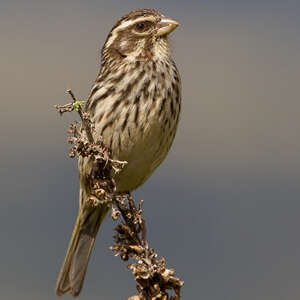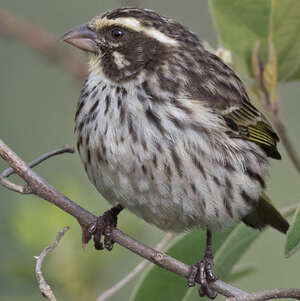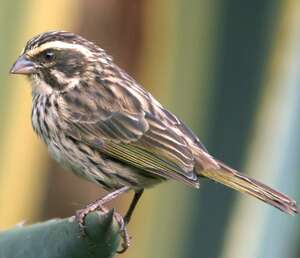Streaky Seedeater
Crithagra striolata - Serin strié
Identification
The Streaky Seedeater is a medium-sized finch, quite stocky and heavily streaked with a large head, short and conical beak and a long lightly-toothed tail. There is no sexual dimorphism. The upperparts are generally brown streaked with buff and the underparts buffish to whitish. The brown head is marked by long and wide buffish-white eyebrows reaching the back of the neck. The lores, parotids and sides of the throat are dark brown, the eye is underlined by a small buffy crescent, and a small variable-sized buffy moustache can be seen on the cheek. Looking in front, a clearly buffish-white tinged, or not, with yellow bib is visible. The base of the conical beak is brown and the mandibles are rosaceous. The iris is brown or chestnut-colored. The legs are dark brown. The cap and the neck are brown, more or less streaked with buff-white. The mantle, back and scapular feathers are brown-olive heavily streaked with blackish-brown and bordered with buff-white. The rump is pale-brown streaked with a darker hue and the rectrices are dark-brown fringed with green-olive. The flight feathers are blackish with the primaries finely bordered with yellow-green or green-olive, and the secondaries bordered by brown-olive becoming largely white. The coverts, chest and flanks are buff-white finely streaked with brown. The belly is whitish more or less streaked. Individuals of the subspecies C. s. graueri are slightly darker on the upperparts than the nominal subspecies C. s. striolata, with fine or indistinct green edgings on the flight feathers, and more heavily streaked on the underparts with a deeper or richer buff-brown. The juvenile is similar to the adult, but duller.The forehead and crown are lighter tans and the lower parts are generally less streaked.
Subspecific information 2 subspecies
- Crithagra striolata striolata (Eritrea, Ethiopia and se Sudan to Tanzania and n Malawi)
- Crithagra striolata graueri (e DRCongo, sw Uganda, Rwanda and Burundi)
Foreign names
- Serin strié,
- Serín estriado,
- canário-listrado,
- Strichelgirlitz,
- Gestreepte Kanarie,
- Beccasemi striato,
- strimsiska,
- Stripeirisk,
- kanárik pásikavý,
- zvonohlík proužkovaný,
- Stribet Sisken,
- viiruhemppo,
- gafarró estriat,
- afrokulczyk kreskowany,
- Пёстрый канареечный вьюрок,
- タテフカナリア,
- 条纹丝雀,
- strimsiska,
- 條紋絲雀,
Voice song and call
The song of the Streaky Seedeater is varied. It can be a series of short, clear and descending whistles tway, tway, tsitsi-peeew, tsiway-tslo or a series of longer notes including trills, short notes and dry chattering. All of these phrases are well separated and can last several seconds. The call is monotonous sweee or chweee-chip-chip-chip-chip or chididi see-leep and fades at the end. Finally he emits other call notes including sooee, seeeeeit or suwee-ip high-pitched.
Habitat
The Streaky Seedeater is accustomed to open landscapes of low and middle mountains. It can also be found on the edges of woods and in clearings, in the middle of secondary humid perennial leaf forests and arborescent heathers. Locally it is encountered in junipers, heaths and alpine meadows, bamboo patches and in the scrub of ferns. It is also not foreign to crops and gardens, including the outskirts of large cities such as Addis Ababa in Ethiopia and Nairobi in Kenya.
Behaviour character trait
The Streaky Seedeater is a resident species. A few short distance and random movements have been observed in Kenya.
These are mainly searches for food shifting from drier areas to wetter areas. These displacements mainly take place when the species is not in the reproductive period. The Streaky Seedeater feeds on the ground up to a medium height in vegetation. It moves alone, in couples or in small groups of 3 to 6 individuals which are usually family groups. Out of the reproductive period it readily joins bird flocks and can frequent feeders and water points provided to birds in courtyards and gardens. The species is rather solitary and very territorial during the breeding season.Dietfeeding habits
Reproduction nesting
Streaky Seedeater reproduces generally throughout the year. In Kenya the period mainly extends from April to August and October to January, but exclusively from April to July when its presence is over 2000 metres.
It can perform up to 3 nestings. In Ethiopia it reproduces from April to October. In Democratic Republic of Congo from March to June and in November and December. In Uganda in January and December. In Rwanda from August to September and finally in October in Tanzania. The species is monogamous in its reproduction system and it nests solitary, which clearly explains its strong territorial character. The nest is a deep and compact cup of vegetal fibers. It is built behind the vegetation so as to be well hidden, to a medium height of 1 to 1.5 metre from the ground and placed in the fork of a branch, bush or shrub. It consists of dry grass, sticks, floral stems, bark, hair and feathers. The female lays 3 to 6 eggs, on average 3. They are of pale blue or whitish color, subtly spotted or bordered of brown and of grey violet. The incubation lasts 12 days and is only performed by the female; she is fed at the nest during this period by the male. The chicks are fed by both parents, generally by regurgitation, during 14 to 17 days according to the meteorological conditions. The mortality rate among young chicks is quite high. The attacks of shrikes and coucals, mongooses, arboreal rats, genets and snakes are frequent. At high altitude, mortality is mainly related to the strong heat waves or cold.Geographic range
The Streaky Seedeater can be found in the high plateaus of East Africa, ranging from Eritrea in the north, where it is abundantly local, to the Albertine Rift and the center of Tanzania. It is also present in the east of the Democratic Republic of the Congo, and in the west of Burundi and Uganda. Its altitudinal distribution then varies according to the country. It generally inhabits elevations between 1300 and 4300 m in Kenya and East Africa, between 1510 and 4100 m in Ethiopia, and between 1675 and 4250 m in the east of the Democratic Republic of the Congo. In Eritrea it can be found as low as 950 m. Two subspecies have been identified. C. s. striolata: in Eritrea, Ethiopia and southeast Sudan, southwards to western and central Kenya and north Tanzania. C. s. graueri: in the east of the Democratic Republic of the Congo, southwest Uganda, Rwanda, and Burundi.
Threats - protection
Sources of information
- IOC World Bird List (v15.1), Gill, F and D Donsker (Eds). 2025-12-07.
- Birds of the World, The Cornell Lab of Ornithology
- eBird, Cornell Lab of Ornithology et National Audubon Society
- Birds of East Africa: Kenya, Tanzania, Uganda, Rwanda, Burundi, Terry Stevenson, John Fanshawe
- Birds of the Horn of Africa, Nigel Redman
Other sources of interest
 Specification sheet created on
17/07/2023 by Nathalie Santa Maria
Specification sheet created on
17/07/2023 by Nathalie Santa MariaTranslation by AI Oiseaux.net
© 1996-2026 Oiseaux.net
- Accipitriformes
- Aegotheliformes
- Anseriformes
- Apodiformes
- Apterygiformes
- Bucerotiformes
- Caprimulgiformes
- Cariamiformes
- Casuariiformes
- Charadriiformes
- Ciconiiformes
- Coliiformes
- Columbiformes
- Coraciiformes
- Cuculiformes
- Eurypygiformes
- Falconiformes
- Galliformes
- Gaviiformes
- Gruiformes
- Leptosomiformes
- Mesitornithiformes
- Musophagiformes
- Nyctibiiformes
- Opisthocomiformes
- Otidiformes
- Passeriformes
- Pelecaniformes
- Phaethontiformes
- Phoenicopteriformes
- Piciformes
- Podargiformes
- Podicipediformes
- Procellariiformes
- Psittaciformes
- Pterocliformes
- Rheiformes
- Sphenisciformes
- Steatornithiformes
- Strigiformes
- Struthioniformes
- Suliformes
- Tinamiformes
- Trogoniformes





























